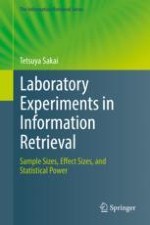2018 | OriginalPaper | Buchkapitel
5. The Correct Ways to Use Significance Tests
verfasst von : Tetsuya Sakai
Erschienen in: Laboratory Experiments in Information Retrieval
Verlag: Springer Singapore
Aktivieren Sie unsere intelligente Suche, um passende Fachinhalte oder Patente zu finden.
Wählen Sie Textabschnitte aus um mit Künstlicher Intelligenz passenden Patente zu finden. powered by
Markieren Sie Textabschnitte, um KI-gestützt weitere passende Inhalte zu finden. powered by
